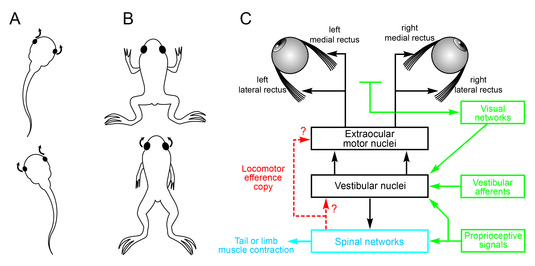Hans Straka
Prof. Straka sadly and unexpectedly passed away in December 2022. His research group will be continued until 2024. For adminstrative inquiries, please contact Dr. Michael Pecka. For research questions, please contact Dr. Maria del Rosario Sanchez-Gonzalez.
https://www.mcn.uni-muenchen.de/aktuelles/hans-straka/index.html
Research group: Sensory motor transformation
All vertebrates, whether running, swimming, or flying, are confronted with the effects of their locomotor actions on their ability to perceive the surrounding environment. In order to maintain visual acuity during locomotion, retinal image drift must be counteracted by dynamic compensatory eye and/or head adjustments that derive from vestibulo-ocular, optokinetic, and proprioceptive reflexes.
Although considerable information is available on the functional organization of amphibian vestibulo-ocular networks and on the neural substrates of locomotor rhythm generation in the tadpole spinal cord, virtually nothing is known about how these two systems interact during effective behavior. Given the conservative organization of central nervous control systems across species, the capacity for oculo-motor adjustments during locomotion throughout frog development raises a number of general neurobiological questions about neural circuit interaction and plasticity. The transition from tadpole to adult involves a drastic change in body plan including the growth of limbs, the regression of the tail and a consequent anatomical and functional restructuring of sensory and motor circuitry. The amphibian metamorphosis in which morpho-physiological changes accompany an alteration in lifestyle and behavioral repertoire requires a high level of neural plasticity. This plasticity makes frogs and salamanders ideal models to understand the basic computational requirements of sensory processing under different locomotor conditions.

Gaze stabilization during Xenopus locomotion. A. In pre-metamorphic tadpoles, horizontal head rotation during swimming necessitates conjugate angular eye movements in opposite directions. B. In post-metamorphic froglets, linear forward thrusts during hind-limb kick propulsion require convergent ocular movements. C. Organization of visuo-vestibular networks and possible interactions with spinal locomotor circuitry. From Combes et al., 2008
Our research is focused on six main topics:
- Signal processing in sensory-motor networks
- Interaction between sensory signals and intrinsic locomotor commands
- Ontogeny of vestibulo-oculomotor reflexes
- Development of gaze and posture stabilization
- Development of the extraocular motor system
- Influence of vestibular signals on the development of body symmetry
Please contact Prof. Straka for research opportunities

